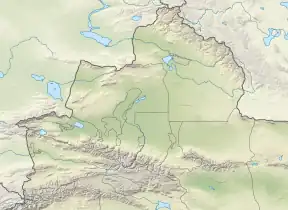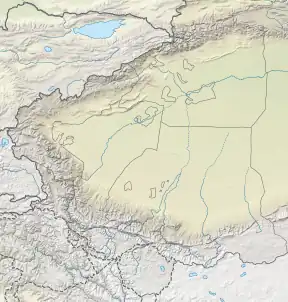| Muzart Pass | |
|---|---|
.jpg.webp) Xiate Valley looking south, Muzart Pass turns right before the snow-capped mountains | |
| Elevation | 3,582 m (11,752 ft)[1] |
| Traversed by | Xiate Trail (夏特古道) |
| Location | between Ili Prefecture and Aksu Prefecture in Xinjiang, China |
| Range | Tian Shan |
| Coordinates | 42°21′32″N 80°47′53″E / 42.359°N 80.798°E |
 Muzart Pass  Muzart Pass | |
| Muzart Pass | |||
|---|---|---|---|
| Traditional Chinese | 木扎爾特達坂 | ||
| Simplified Chinese | 木扎尔特达坂 | ||
| |||
The Muzart Pass, Muz-art Pass, or Muzat Pass[2] (Chinese: 木扎尔特达坂) is a high mountain pass[3] that crosses the Tian Shan mountains in Xinjiang, China. It connects the city of Aksu in Tarim Basin with the city of Yining (Kulja) in the upper Ili River valley.[1] It is located on the county boundary between Zhaosu County in Ili Prefecture and Baicheng County in Aksu Prefecture. The route over Muzart Pass is more commonly referred to as Xiate Trail (Chinese: 夏特古道) by the Chinese,[1] Xiate being the name of the village in Tekes River valley at the base on the northern side of the route.
China National Highway 219 is in the process of being extended to cross Tian Shan connecting Zhaosu County with Wensu County in Tarim Basin. There are two routes under investigation -- the western and shorter route will traverse Muzart Pass.[4]
Etymology
According to Chinese sources, muz-art is derived from the Mongolic word for "glacier".[5] It has also been interpreted to mean "ice pass" by Western sources[6] as that is its meaning if read as Uzbek.[7]
History
British explorer Henry Lansdell, who traversed this route in the late 1800s, believed the famous Chinese explorer Xuanzang who inspired the Chinese classic Journey to the West used this mountain pass in the 7th century on his journey to India.[6] However, number of scholars argue that it was Bedel Pass,[8] as Xuanzang described the passage was northwest of "Kingdom of Baluka",[9] modern day city of Aksu.[10]
During the Qing dynasty, this pass was of strategic military importance as it was the main artery of communication between Tarim Basin in southern Xinjiang and the Qing power base at Ili in northern Xinjiang. Due to the Muzart Glacier, the Qing government had spent much labor keep this mountain pass traversable.[2][11] During the Dungan Revolt of 1862–1877 by Yakub Beg, this labor stopped and it became impassible. Around 1870 during the revolt, the Russians took control of the pass to prevent Yakub Beg from advancing on Kulja,[12] trade interest that the Russians acquired in Treaty of Kulja. After the Qing reconquest of Xinjiang in 1879, the initially negotiated Treaty of Livadia between Russian Empire and Qing, if ratified, would have ceded this mountain pass along with much of Ili Valley to Russia. With the support other European powers, the treaty was renegotiated and became the 1881 Treaty of Saint Petersburg.[13] In 1907, future-President of Finland Gustaf Mannerheim, while serving as an intelligence officer in the Imperial Russian Army, passed through here.[14] His mission was to determine the feasibility of invading China by the Russian Empire.[15]
In 1992, the Narynkol–Muzart border crossing with Kazakhstan was temporarily opened.[16] It was hoped a highway would be built over this pass, allowing the port to connect Tarim Basin with Kazakhstan.[17] However, that never happened. Thus, the crossing was closed as it lacked traffic.[16]
In recent years, Xiate Hot Springs, a tiny village on the north slope downhill from the pass, has been developed into a tourist destination[1] and there are tour groups that would traverse part of the trail.[18]
See also
 "White mountain" in the Muzart Pass sketched by Henry Lansdell in 1893
"White mountain" in the Muzart Pass sketched by Henry Lansdell in 1893 Xiate Hot Springs, a settlement on the north slope that has been developed into a tourist destination[1]
Xiate Hot Springs, a settlement on the north slope that has been developed into a tourist destination[1]
References
- 1 2 3 4 5 Paul Knott; Bruce Normand (2009). "Untapped Potential, Exploring the Chinese Central Tien Shan". American Alpine Journal. Retrieved 4 February 2020.
The historic Xiate Trail traverses the range from north to south. This was an important trade route from Ili over to the Muzart Gorge, and hence to the Aksu region and southern Xinjiang. The trail is notable for crossing glacial terrain and a high pass at 3,582 meters. ... A short drive from Zhaosu took us to the roadhead at Xiate Hot Springs (2,380m). ... the authorities are developing the Xiate Valley as a tourist center. A new concrete bridge and hotel are under construction at the hot springs and an upgrade of the access road is mostly complete. ... Above the pastures we followed a good trail over the Muzart Pass (3,582m) to a base camp at Hadamuzi (3,525m), a beautiful meadow overlooking the Muzart (Benzhaerte) Glacier directly opposite Baiyu Feng.
- 1 2 Journal of the Society of Arts. The Society. 1873. p. 321.
Next, the Muzat Pass, leading between Aksu and Russian Kulja, lies over a formidable glacier, where I am assured that 40 men are kept at work in the summer roughing the ice for the passage of the caravans.
- ↑ Demetrius Charles Boulger, A Life of Yakub Beg, 1878, pages 7,12,61.
- ↑ 李剑 (2021-10-18). "从北疆到南疆 219国道 如何穿越南天山?". Chinese National Geography. Retrieved 23 February 2022.
经过勘察这条线路有两个方案:西线走廊,昭苏县至温宿县,部分路线与夏特古道重合,里程445公里;东线走廊,特克斯县至拜城县,部分线路与乌孙古道重合,里程580公里。两条线路都需要打隧道才能通过达坂,昭苏至温宿线需要长度16公里的隧道;特克斯至拜城线需要长度40—80公里的隧道,工程难度更大。
- ↑ 许立国 (2013-06-18). "巍峨壮观的"木扎尔特冰川"" (in Chinese). 新疆兵团十二师公安局信通科. Retrieved 6 February 2020 – via forestry.gov.cn.
"木扎尔特冰川",又称"木素尔岭达坂",蒙古语的意思,是"白冰川"
- 1 2 Henry Lansdell (1894). Chinese Central Asia: A Ride to Little Tibet. Scribner. p. 200,279.
(p200) The third and shortest route was up the Tekes valley, and over the Muzart, or Ice Pass (p279) Over the Muz-Davan, or Ice Pass ... Hiuen Tsiang, my worthy and only predecessor of note in this portion of the Pas
- ↑ "Uzbek-English Dictionary". Center for Turkic and Iranian Lexicography and Dialectology. Retrieved 6 February 2020.
muz n. 1) ice 2) fig. cold, unpleasant; art n. mountain pass
- ↑ E.J. van Donzel; Andrea Schmidt (17 May 2010). Gog and Magog in Early Eastern Christian and Islamic Sources: Sallam's Quest for Alexander's Wall. BRILL. pp. 248–249. ISBN 978-90-474-2762-9.
Xuanzang could have attacked the mountain ... where the road to Kuldja leads to the 'Muzart Art' or Icy Pass ... Chavannes and Smith, however, are of the opinion that Xuanzang took the Bedel Pass.
- ↑ Xuanzang. [Kingdom of Baluka]. Great Tang Records on the Western Regions (in Chinese). Vol. 1 – via Wikisource.
- ↑ John E. Hill (July 2003). "Section 20 – The Kingdom of Suoche 莎車 (Yarkand).". Notes to The Western Regions according to the Hou Hanshu (2nd ed.). Washington University. Retrieved 3 February 2020.
Neolithic artefacts from 5000 BC have been discovered in the Aksu area. By the first century BC news had reached the Chinese imperial court of the Kingdom of Baluka, one of the 36 kingdoms of the Western Regions.
- ↑ Arminius Vambery (1874). "The Tekes Valley and the Muzart Pass". Ocean Highways: The Geographical Record. N. Trübner and Company. p. 92–93.
The road from Kuldja to Aksu cuts right across the Tekes valley, climbs the ridges of the Tien-shan, and sinks gradually down to Aksu. During the period of Chinese rule this was the main artery of communication between Ili district and Kashgar ... At the entrance of the so-called Muzart Pass the road turns on both sides of the Muzart brook. ... the Russians will take care to re-establish this road
- ↑ Hodong Kim (25 February 2004). Holy War in China: The Muslim Rebellion and State in Chinese Central Asia, 1864-1877. Stanford University Press. p. 141. ISBN 978-0-8047-6723-1.
The Russian army took a preemptive measure by blocking the Muzart pass to cut the road from Kashgaria to Kulja.
- ↑ Jesse Wang (19 March 1971). "The Military Significance of the Sino-soviet Border in Central Asia" (PDF). Army War College. Archived from the original (PDF) on February 5, 2020. Retrieved 5 February 2020.
In September 1879, Chinese Ambassador Chunghow had signed the Treaty of Livadia, by which the western, richer and larger part of the Ili valley area; the passes through the T'ien Shan, especially the Muzart Pass for the military road between Kuldja and Aksu; and five million rubles for occupation expenses were to be given to Russia. ... Much maneuvering took place among European powers who did not wish Russia to gain too much of an advantage in China. ... Russia and China went to the brink of a border war before Marquis Tseng Ki-tse (Tseng Chi-Tse), a replacement ambassador, negotiated the Treaty of St. Petersburg
- ↑ Eric Enno Tamm (2012). "The Horse that Leaps Through Clouds". Retracing Mannerheim's Journey Across Asia. Horse That Leaps Through Clouds. Retrieved 4 February 2020.
Gustaf Mannerheim ventured northward to the foothills of the Tian Shan range. The Chief of the Russian General Staff had instructed him to conduct reconnaissance of the alpine passes and ethnic groups living in the shadow of the Tian Shan range. He left Kashgar on January 25, 1907 for a gruelling six-month trek that would bring him to Urumqi, the regional capital of Xinjiang. ... Mannerheim made a hundred-kilometre trek across the Tian Shan range through the Muzart Pass
- ↑ Christopher Caldwell (11 August 2017). "Start to Finnish". Washington Examiner. Retrieved 4 February 2020.
It was an 8,000-mile spying expedition. Russia was drawing up plans to invade China from the west—but failed to.
- 1 2 Peyrouse, Sébastien (2008). "Chinese Economic Presence in Kazakhstan". China Perspectives. 2008 (3): 34–49. doi:10.4000/chinaperspectives.4053. ISSN 2070-3449.
A sixth post, Narynkol-Muzart, located near the Kyrgyz border, which opened in 1992, has closed due to lack of traffic.
- ↑ 刘红忠 (1993-04-14). "木扎尔特口岸". 新疆地方志 (in Chinese). ISSN 1004-1826. Retrieved 4 February 2020.
木扎尔特口岸 ... 夏塔至南疆的公路打通后,南疆的货物可由此出口。
- ↑ "Road to paradise". China.org.cn. July 2, 2010. Retrieved 4 February 2020.